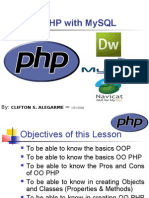Introduction to PHP objects
Uploaded by
rojamani gantaIntroduction to PHP objects
Uploaded by
rojamani gantaIntroduction to PHP objects
Definition
In PHP, objects are instances of a class, which is a blueprint for creating
objects with specific properties and methods.
An object is a data type that can store data and functions together in a
single unit. Objects are created using the new keyword followed by the
class name. Once an object is created, you can access its properties and
methods using the arrow notation (->).
A class can have properties, which are variables that store data, and
methods, which are functions that perform actions on the object. Classes
can also have constructors, which are special methods that are called
when an object is created, and destructors, which are special methods
that are called when the object is destroyed.
Examples
class Car {
public $make;
public $model;
public $year;
public $color;
public function startEngine() {
return "Engine started";
}
}
$myCar = new Car();
$myCar->make = "Toyota";
$myCar->model = "Camry";
$myCar->year = 2020;
$myCar->color = "black";
echo $myCar->startEngine(); // Output: Engine started
In this example, the Car class has four properties: make, model, year,
and color. It also has one method: startEngine(). A new object of the
class Car is created and assigned to the variable $myCar, after that, the
properties of the object are set, and the method of the object is called.
Object-oriented programming (OOP) is a programming paradigm that is
based on objects, classes, and their interactions. OOP allows you to create
modular and reusable code, making it easier to maintain and update.
<?php
class Person {
public $name;
public $age;
public $gender;
public function __construct($name, $age, $gender) {
$this->name = $name;
$this->age = $age;
$this->gender = $gender;
}
public function introduce() {
return "Hello, my name is " . $this->name . ", I am " . $this->age . "
years old and I am " . $this->gender . ".";
}
}
$person1 = new Person("John", 30, "male");
$person2 = new Person("Mary", 25, "female");
echo $person1->introduce(); // Output: Hello, my name is John, I am 30
years old and I am male.
echo $person2->introduce(); // Output: Hello, my name is Mary, I am 25
years old and I am female.
?>
You might also like
- Object-Oriented Programming With PHP - (Bonus Chapter 2)No ratings yetObject-Oriented Programming With PHP - (Bonus Chapter 2)26 pages
- PHP Tutorials Examples Object Oriented Programming With PHPNo ratings yetPHP Tutorials Examples Object Oriented Programming With PHP24 pages
- Chapter - 3 Apply Object Oriented Concepts in PHP Marks-16: Notes by - G. R. Jagtap 1No ratings yetChapter - 3 Apply Object Oriented Concepts in PHP Marks-16: Notes by - G. R. Jagtap 123 pages
- 220246-Web Based Application Development with PHP - 22619 - Unit 3No ratings yet220246-Web Based Application Development with PHP - 22619 - Unit 317 pages
- Object Oriented Programming in PHP: CS-02: Advance Web Development in LaravelNo ratings yetObject Oriented Programming in PHP: CS-02: Advance Web Development in Laravel28 pages
- PHP Object Oriented Programming (OOP) : Creative Commons Attribution-Share Alike 4. 0 International LicenseNo ratings yetPHP Object Oriented Programming (OOP) : Creative Commons Attribution-Share Alike 4. 0 International License78 pages
- Tip: The "Don't Repeat Yourself" (DRY) Principle Is About Reducing The Repetition of Code. YouNo ratings yetTip: The "Don't Repeat Yourself" (DRY) Principle Is About Reducing The Repetition of Code. You37 pages
- More On PHP: Objects and Sessions Autumn 2011No ratings yetMore On PHP: Objects and Sessions Autumn 201119 pages
- Oop PHP With Mysql: Clifton S. AlegarmeNo ratings yetOop PHP With Mysql: Clifton S. Alegarme32 pages
- Unit - 3 Apply Object Oriented Concepts in PHPNo ratings yetUnit - 3 Apply Object Oriented Concepts in PHP21 pages
- Unit -3 Apply Object Oriented Concepts in PHPNo ratings yetUnit -3 Apply Object Oriented Concepts in PHP39 pages
- Chapter 3-Apply Object Oriented Concepts in PHPNo ratings yetChapter 3-Apply Object Oriented Concepts in PHP39 pages
- IGNOU PGDCA MCS 206 Object Oriented Programming using Java Previous Years solved PapersFrom EverandIGNOU PGDCA MCS 206 Object Oriented Programming using Java Previous Years solved PapersNo ratings yet
- All Engineering Syllabus 05-11-2021 LatestNo ratings yetAll Engineering Syllabus 05-11-2021 Latest879 pages




































































